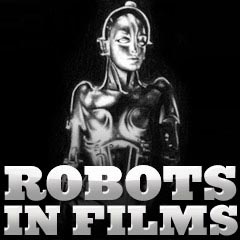
|
A Complete Illustrated History of Robots in the Movies 1968 to 1973 |
| Film/Year, Name of Robot and Film Description | ||||||||
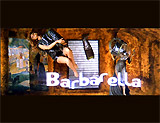
|
Barbarella (1968, Fr./It.) (aka Barbarella: Queen of the Galaxy)
During Barbarella's (Jane Fonda) mission from Earth to the planet Lythion to find young scientist Durand-Durand (Milo O'Shea), she was forced to battle mechanical, razor-toothed robot devil dolls. |
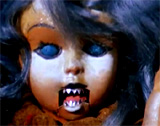 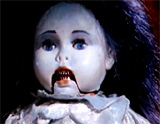 |
||||||
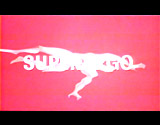
|
Superargo and the Faceless Giants (1968, It./Sp.) (aka L'invincibile Superman)
This superhero action film co-produced from Italy-Spain was a sequel to Superargo vs. Diabolicus (1966). The title character was black leather-masked, red-hooded and caped, and red tights-wearing superhero secret agent-crusader Superargo (Ken Wood aka Giovanni Cianfriglia) - a square-jawed ex-pro wrestler who fought crime with his turbaned Indian mystic sidekick Kamir (Aldo Sambrell). He possessed super-powers of telepathy, levitation and other mental abilities. A number of kidnappings and bank thefts were occurring, conducted by unstoppable, robotized, helmeted, 'faceless giants' - a horde of mechanical enemies. In reality, the giants weren't faceless (they had pantyhose stockings pulled over their faces), and they were not giant-sized. The Secret Service commissioned Superargo to stop the mad scientist and master criminal Professor Wendland Wond (Guy Madison). His army was kidnapping world class athletes, and replacing them with the 'faceless giants' of the film's title - robotized super-athletes. It was a curious premise - why abduct the world's best athletes and turn them into slow-moving robotic zombies?
|
 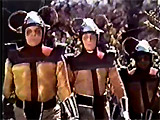 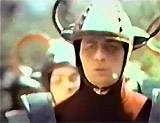
|
||||||

|
Stanley Kubrick's landmark science-fiction film was based on Arthur C. Clarke's The Sentinel. The Discovery spaceship, on a nine-month, manned mission to Jupiter, was intelligently controlled and monitored by a "sixth member of the Discovery crew" - an even-toned, talkative, alert, "thinking" and "feeling" super-computer with Artificial Intelligence, named HAL-9000. HAL maintained the electronic systems of the spaceship (HAL "became operational at the H A L plant in Urbana, Illinois on the 12th of January, 1992"). It had anthropomorphic, human-mimicking qualities: a glowing, watchful red eye with which he connected to the world, and a rich, pleasant TV announcer's voice (voice by Douglas Rain). Although appearing and sounding robotic, HAL was not really a traditional robot with a moving body. HAL was an acronym that stood for "Heuristically programmed ALgorithmic computer." HAL was capable of speech recognition (lip-reading), chess-playing, sophisticated language interpretation, and, of course, malevolence. In the film's most dramatic scene, astronaut Dave Bowman (Keir Dullea) turned off HAL's cognitive functions by removing brain modules arranged as panels/arrays - he floated through the computer's memory bank, de-braining, lobotomizing, dismantling and disconnecting HAL's higher-logic functions by ejecting components of HAL's auto-intellect panels (shaped like tiny white monoliths). HAL pleaded and protested with Bowman - in a programmed voice - as his 'mind' gradually decayed and he became imbecilic and returned to infancy, while singing the song Daisy, or A Bicycle Built for Two. |
 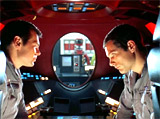 
|
||||||
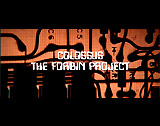
|
Colossus: The Forbin Project (1970)
In this low-budget, cautionary science fiction film set during the Cold War Era and based on the 1966 novel by Dennis Feltham Jones, the AI 'robot' was a mainframe super-computer code-named Colossus, similar to HAL-9000 in 2001: A Space Odyssey (1968).
The film also postulated that the Soviet Communists had built an identical super-computer named Guardian to control their defense system - setting up the film's plot that the two computers would be linked together, run amok and threaten world destruction (with nuclear blackmail by firing ICBMs on each other), a common theme of films at the time (e.g. The Andromeda Strain (1971), THX 1138 (1971), and Westworld (1973)). |
 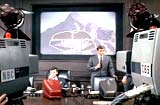 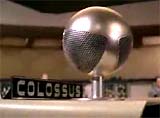
|
||||||

|
THX 1138 (1971)
George Lucas' feature-length debut film was about a post-apocalyptic, oppressive futuristic, underground police state world of the 25th century, where people were required to wear white gowns and shave their heads. The society was patrolled by hundreds of identical, black leather-clad, chrome-faced android-robot enforcement cops with white motorcycle helmets, long baton-sticks or cattle prods, and radioactive power supplies. A few of the society's individuals, including robot-building production line worker THX 1138 (Robert Duvall) and his female roommate LUH 3417 (Maggie McOmie) - after not taking their state-required and prescribed, anti-emotion drug doses - began to experience illegal sexual feelings for each other, but then were caught and arrested by the black-garbed police. |
 
|
||||||

|
Silent Running (1972)
Douglas Trumbull's directorial debut film was a speculative vision of eco-disaster. The environmental story about the aftermath of a nuclear holocaust featured three, beautifully-designed, faceless, silent, ecologically-friendly, anthropomorphic drones or robots named Huey, Dewey, and Louie. [Note: The three drone robots were the first non-humanoid film robots that were propelled to walk and operated by human amputee actors hidden inside their boxy frames.] They were low-profile, 3 foot-tall robots with retractable, pneumatic arms and a front-mounted searchlight, originally named Drones 1-3, but then re-named after Donald Duck's nephews Dewey, Huey, and Louie (colored blue, orange, and green respectively), and the inspiration for Star Wars' R2-D2 robot. They were the innocent and protective robotic companions of rebellious, monk-robed, hippie loner botanist-ecologist Freeman Lowell (Bruce Dern) on the orbiting space-freighter-greenhouse Valley Forge around Saturn, carrying out a mission of tending to the last remaining plant specimens from a radiation-devastated planet Earth. In their spare time, the drones played poker with Freeman. Ordered to destroy the geodesic greenhouse domes, Freeman refused and hijacked the ship with one remaining dome, when he decided to refoliate a destroyed Earth with the last surviving vegetation. Huey was lost in space as the ship jettisoned away and flew through the rings of Saturn, and Dewey became the sole survivor left to tend the last remaining dome after Freeman blew up the spaceship and himself. |
 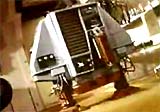
|
||||||
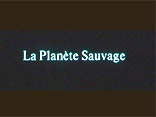
|
Fantastic Planet (1973, Fr./Czech.) (aka Planète Sauvage, La, or The Savage Planet)
René Laloux's surrealistic animated film featured themes of oppression and rebellion, and was the winner of the Special Grand Prix jury prize at the 1973 Cannes Film Festival. It told about an alien race of giant blue robotic creatures called Draags, superior beings on the futuristic planet of Ygam. They ruled over the "Oms" - tiny kidnapped humanoids from an Earth-like planet, some of which were kept by the Draag children as domesticated pets with collars. The Draags had bluish skin, huge round and protruding red eyes, and a skull-like head. The tale concluded with a chronologically-reversed Planet of the Apes (1968) twist ending. |
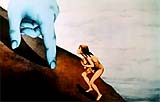 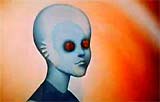
|
||||||
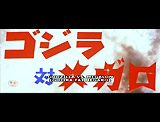
|
Gojira Tai Megaro (1973, Jp.) (aka Godzilla vs. Megalon)
In director Jun Fukuda's low-budget science-fiction film (the 13th Godzilla film and the fourth for Fukuda), monstrous bipedal, winged, stag beetle-like Megalon (with drill-bit hands and capable of shooting laser rays from his head) from an ancient subterranean civilization called Seatopia attempted to take over Earth. Godzilla came to the rescue after being informed on Monster Island by experimental robot Jet Jaguar, a cone-headed android capable of flying, wearing an orange-red-silver colored rubber suit. It was shown that the robot was programmed by punch cards, and capable of transforming himself into giant size. The final showdown battle (a tag-team wrestling match that was about one-half hour long) pitted Godzilla and Jet Jaguar against two space monsters (Megalon and one-eyed cyclopean dinosaur-like buzzard Gigan). |

|
||||||
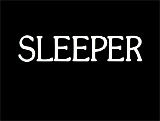
|
Woody Allen's satirical comedy about the future opened with jazz clarinet musician and co-owner of a Greenwich Village health food store, the nerdy Miles Monroe (Allen), waking up in the dystopic world of 2173 after being cryo-frozen with liquid nitrogen after a botched surgery. When first unwrapped and awakened, he staggered around (backwards) like a zombie-like Frankenstein. To escape detection and capture, he ineptly pretended to be a servant-robot, with a silver-painted face and dome on his head (although he still retained his black-framed thick glasses), in the household of hedonistic poetess Luna Schlosser (Diane Keaton) during a party. In the house party scene, Miles as the robotic butler participated in the passing of the pleasure-producing "intoxication orb" - and tried to pretend that he wasn't affected by it. The film also featured a robotic workshop to repair his defective robotic head, and a computerized, blue-eyed robotic Rags pet dog that barked: "Woof woof woof...Hello, I'm Rags..." - accompanied by Miles' question:
|
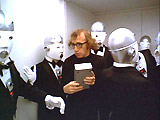 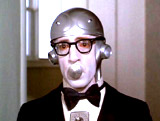   
|
||||||
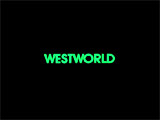
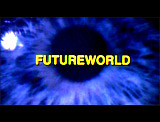
|
Westworld (1973)
Writer/director Michael Crichton's original film was about a remote, adult-entertainment theme park named Delos populated with androids in three different worlds: Medieval World, Roman World and Westworld. The experience was designed to provide visitors with a "vacation of the future" (with heavy doses of sex and violence) for $1,000/day:
The sci-fi thriller followed the role-playing experiences of first-time nerdy "new-in-town" visitor Peter Martin (Richard Benjamin) and his pal John Blane (James Brolin) at Westworld, acting out archetypal 'western' fantasies: a mock saloon and a quick-draw shootout with the Magnificent Seven's cold and mechanical gunslinger (Yul Brynner) (with authentic blood splatter) - a black-clad Cowboy automaton robot, who allowed visitors to kill him in shooting matches. Then, the two bedded down of a pair of honky-tonk prostitutes (one was showing signs of defectiveness in her eyes). an escape-breakout from a sheriff's jail-cell, a cyborg rattlesnake bite, a rollicking bar-room brawl, and a third showdown at high-noon with the gunslinger in the middle of the dusty town (resulting in Blane's actual death!). Every night, trucks collected the damaged robots and took them to an underground lab where they were cleaned and repaired by white-coated lab technicians, and controlled by giant computers. Ultimately, the scientists died of oxygen deprivation when the entire resort's computers began to spread breakdowns (like a viral disease) among the androids (who became disobedient and began harming guests) - and the scientists became locked in the control room when they shut down the park's power The cold and expressionless gunslinger, after being revived numerous times by the scientists - was shown to possess ultra-sonic hearing and magnified, infrared vision (represented by red-tinted POV shots), demonstrating the first use in a feature film of 2-D CGI. When the Gunslinger went beserk and ran amok in the park, threatening sole surviving Peter, it withstood melting by hydrochloric acid thrown in its face, and being set on fire with a torch. Eventually, its backup power supply failed and its charred remains short-circuited. |
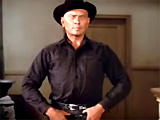   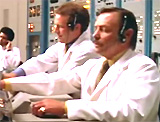 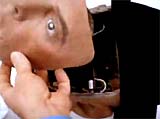 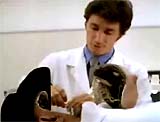 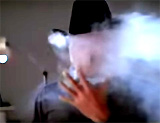 
|
||||||

|
Who ? (1973, UK/W. Germ.) (aka Roboman, and The Man With the Steel Mask)
Director Jack Gold's Cold War-era action-espionage thriller and suspenseful character study was about an identity crisis. The plot was based upon Algis Budrys' 1958 philosophical sci-fi novel Who ?, a tale of political espionage. Its major stars were Elliott Gould and Trevor Howard. For its video VHS re-release, the film was renamed Roboman and given the tagline: "The Kill Machine with the Megaton Mind" (to capitalize on the popularity of Robocop (1987)). In the story (told with flashbacks), American government official and US scientist Dr. Lucas Martino (Joseph Bova) had been seriously injured in a deadly car accident in East Germany (Russian territory). After the crash he was brought to a secluded location by the Russians, who interrogated him. But first, they administered experimental surgery to rebuild most of the scientist's body with metal implants and cybernetic components. Martino was turned into a robotic, metal-faced and armed cyborg with a steel mask (a bald silvery head). He was mostly metal, with human eyes and one human arm.
After the US forced the Russians to release the cyborg scientist, Roboman/Martino was kept under surveillance to discover who he really was. Due to the suspicious circumstances, Martino was not allowed to return to his super-secret work on Project Neptune. Skeptical FBI agent Sean Rogers (Elliott Gould) struggled to verify if the 'mechanical man' was really Lucas Martino. He was suspicious that devious senior Soviet KGB agent Colonel Azarin (Trevor Howard) may have sent back an imposter secret agent in place of the scientist, or even a brainwashed double-agent victim. As the film ended, Martino had given up trying to get his former life (and top secret project work) restored. He took up farming on his abandoned family farm. |
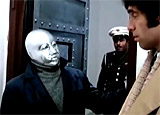 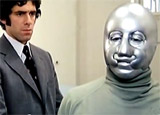 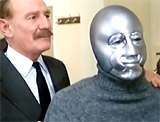 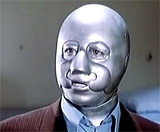 
|
||||||